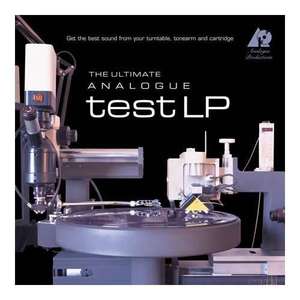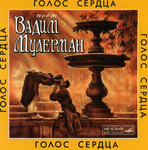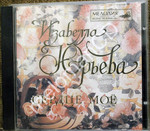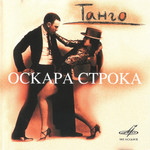The Ultimate Analogue Test LP (200g) (Limited-Edition)
Артикул: CDVP 828133
EAN: 0753088700118
Состав: LP
Состояние: Новое. Заводская упаковка.
Дата релиза: 17-08-2010
Лейбл: Acoustic Sounds AAPJ 128-33
Общий опорный уровень
Дорожка 1 - опорный тон 1 КГц 7 см/с моно, синфазный (Lateral)
Регулировка азимута
Дорожка 2 - опорный уровень 1кГц Только левый канал
Дорожка 3 - опорный уровень 1кГц Только правый канал
Регулировка высоких частот
Дорожка 4 - тональный сигнал 1 кГц на уровне -20 ниже опорного уровня, Латеральный
Дорожка 5 - опорный тон 10 кГц при -20 дбу, Латеральная
Дорожка 6 - развертка от 1 кГц до 20 кГц при -20 дБу, моно (боковая)
Регулировка...
Дорожка 1 - опорный тон 1 КГц 7 см/с моно, синфазный (Lateral)
Регулировка азимута
Дорожка 2 - опорный уровень 1кГц Только левый канал
Дорожка 3 - опорный уровень 1кГц Только правый канал
Регулировка высоких частот
Дорожка 4 - тональный сигнал 1 кГц на уровне -20 ниже опорного уровня, Латеральный
Дорожка 5 - опорный тон 10 кГц при -20 дбу, Латеральная
Дорожка 6 - развертка от 1 кГц до 20 кГц при -20 дБу, моно (боковая)
Регулировка...
Общий опорный уровень
Дорожка 1 - опорный тон 1 КГц 7 см/с моно, синфазный (Lateral)
Регулировка азимута
Дорожка 2 - опорный уровень 1кГц Только левый канал
Дорожка 3 - опорный уровень 1кГц Только правый канал
Регулировка высоких частот
Дорожка 4 - тональный сигнал 1 кГц на уровне -20 ниже опорного уровня, Латеральный
Дорожка 5 - опорный тон 10 кГц при -20 дбу, Латеральная
Дорожка 6 - развертка от 1 кГц до 20 кГц при -20 дБу, моно (боковая)
Регулировка низких частот
Дорожка 7 - развертка от 1 кГц до 20 Гц при 0 VU (боковая)
Дорожка 8 - опорный тон 100 Гц при 0 ВУ (боковая)
Дорожка 9 - Регулировка VTA
Дорожка 10 - Стандартный тестовый сигнал Wow & Flutter; 3150 Гц
Дорожка 1 - Тест на антискейтинг; амплитудная развертка 315 Гц до +12 дБу (латеральная)
Дорожка 2 - Розовый шум по бокам
Дорожка 3 - Розовый шум по вертикали
Дорожка 4 - 1кГц @ опорный уровень, вертикальная
Дорожка 5 - развертка от 1 кГц до 10 Гц при -20 ниже
Дорожка 6 - Тихая канавка для гула подшипников и изоляции стола
Дорожка 1 - опорный тон 1 КГц 7 см/с моно, синфазный (Lateral)
Регулировка азимута
Дорожка 2 - опорный уровень 1кГц Только левый канал
Дорожка 3 - опорный уровень 1кГц Только правый канал
Регулировка высоких частот
Дорожка 4 - тональный сигнал 1 кГц на уровне -20 ниже опорного уровня, Латеральный
Дорожка 5 - опорный тон 10 кГц при -20 дбу, Латеральная
Дорожка 6 - развертка от 1 кГц до 20 кГц при -20 дБу, моно (боковая)
Регулировка низких частот
Дорожка 7 - развертка от 1 кГц до 20 Гц при 0 VU (боковая)
Дорожка 8 - опорный тон 100 Гц при 0 ВУ (боковая)
Дорожка 9 - Регулировка VTA
Дорожка 10 - Стандартный тестовый сигнал Wow & Flutter; 3150 Гц
Дорожка 1 - Тест на антискейтинг; амплитудная развертка 315 Гц до +12 дБу (латеральная)
Дорожка 2 - Розовый шум по бокам
Дорожка 3 - Розовый шум по вертикали
Дорожка 4 - 1кГц @ опорный уровень, вертикальная
Дорожка 5 - развертка от 1 кГц до 10 Гц при -20 ниже
Дорожка 6 - Тихая канавка для гула подшипников и изоляции стола
НЕЗАКОННОЕ ПОТРЕБЛЕНИЕ НАРКОТИЧЕСКИХ СРЕДСТВ, ПСИХОТРОПНЫХ ВЕЩЕСТВ, ИХ АНОЛОГОВ ПРИЧИНЯЕТ ВРЕД ЗДОРОВЬЮ,
ИХ НЕЗАКОННЫЙ ОБОРОТ ЗАПРЕЩЕН И ВЛЕЧЕТ УСТАНОВЛЕННУЮ ЗАКОНОДАТЕЛЬСТВОМ ОТВЕТСТВЕННОСТЬ.
Треклист
Side 1
General Reference Level
This 1 kHz reference tone will allow you to establish a “base level” for all measurements.
Track 1 1Khz reference tone 7cm/s Mono, in phase (Lateral)
Basic reference for all measurements, adjust meter for maximum convenience (in the studio 0VU).
Adjust preamp channel balance for equal output.
Also used to check the offset angle of the photo cartridge; L&R signals should be exactly in phase as displayed on an oscilloscope.
Azimuth Adjustment
Track 2 1kHz reference level Left channel only
Measure Right channel output.
Track 3 1kHz reference level Right channel only
Measure Left channel output.
The object is to sit the stylus exactly perpendicular in the groove.
Twist cartridge about its radial axis until the measurements from Track 2 and Track 3 are equal or very close to equal for both channels.
High Frequency Adjustment
Tracks 4, 5 and 6 are used to calibrate the RIAA high frequency equalizer of a phono preamp. This will be used to calibrate a mastering lathe’s phono preamplifier or any phono preamplifier that has these adjustments.
Track 4 1 kHz tone at -20 below reference level, Lateral
Side 1
General Reference Level
This 1 kHz reference tone will allow you to establish a “base level” for all measurements.
Track 1 1Khz reference tone 7cm/s Mono, in phase (Lateral)
Basic reference for all measurements, adjust meter for maximum convenience (in the studio 0VU).
Adjust preamp channel balance for equal output.
Also used to check the offset angle of the photo cartridge; L&R signals should be exactly in phase as displayed on an oscilloscope.
Azimuth Adjustment
Track 2 1kHz reference level Left channel only
Measure Right channel output.
Track 3 1kHz reference level Right channel only
Measure Left channel output.
The object is to sit the stylus exactly perpendicular in the groove.
Twist cartridge about its radial axis until the measurements from Track 2 and Track 3 are equal or very close to equal for both channels.
High Frequency Adjustment
Tracks 4, 5 and 6 are used to calibrate the RIAA high frequency equalizer of a phono preamp. This will be used to calibrate a mastering lathe’s phono preamplifier or any phono preamplifier that has these adjustments.
Track 4 1 kHz tone at -20 below reference level, Lateral
Reference for High Frequency test.
Track 5 10 kHz reference tone at -20dbu, Lateral
Adjust the high frequency until the output level equals that of Track 4.
Track 6 1 kHz to 20 kHz sweep at -20dbu, Mono (Lateral)
The AC millivoltmeter reading should stay constant across all frequencies. There are a number of factors which can affect frequency response, including cable capacitance, cartridge loading, tracking force and worn parts. Because of this, it can be difficult to achieve perfectly flat frequency response. Sometimes by making small compromises in the 10 kHz adjustment, a better overall frequency response can be achieved.
Low Frequency Adjustment
Tracks 7 & 8 are used to calibrate the RIAA low frequency equalizer of a phono preamp.
Track 7 1 kHz to 20 Hz sweep at 0 VU (Lateral)
Play Track 7 and measure the output with your AC millivolt meter.
Ideally, the output will be flat across all frequencies. When viewed on an oscilloscope, the amplitude would remain constant during the frequency downsweep.
Track 8 100 Hz reference tone at 0 vu (Lateral)
Adjust LF Eq to reference (which is your reading from Track 1).
Track 9 VTA adjust
This is an IEC intermodulation distortion (IMD) test signal; 60Hz & 4kHz 4:1 ratio.
Using an IMD tester, adjust VTA by raising or lowering the tonearm for minimum distortion.
Track 10 Standard Wow & Flutter test signal; 3150Hz
The Wow & Flutter meter will give dynamic speed variations as a percentage deviation from nominal.
Also, the frequency counter should read exactly 3150 Hz for nominal speed. You can use the Hz function on your multi-meter (if so equipped) to verify speed here as well. You can also use to find the measurements at 45RPM. The correct reading at 45RPM would be 4253 Hz (45/33.33) x 3150.
Side 2
Track 1 Anti-skating test; 315Hz amplitude sweep to +12dbu (Lateral)
Signal should remain clean in both channels up to the highest level, both audibly and as viewed on an oscilloscope. In case of distortion, increase anti-skating force or decrease anti-skate until breakup occurs equally in both channels. The left channel information is inscribed on the inner groove wall, the right channel information, on the outer groove wall. Because of the offset angle of a pivoted tonearm, a constantly varying vector force biases the arm towards the center of the record causing the stylus to lose contact with the outer (i.e. right channel) groove wall. Both linear and modulated groove velocity, tracking force, stylus profile, and vinyl composition are contributing factors. The anti skating force attempts to ameliorate this by applying an opposing similar force.
It is also accepted that the overall force vector increases as the tonearm approaches closer to the spindle or end of the record.
Track 2 Pink noise lateral
Track 3 Pink noise vertical
Used for cartridge “demagnetizing”
You can also use this track to loosen up the cantilever’s suspension to help break in a new cartridge. Play these tracks five to ten times after every 300 hours of normal LP playback.
Track 4 1kHz @ reference level, vertical
This out-of-phase signal should cancel to nothing when summed to mono.
Any signals still present are distortion artifacts, lack of channel balance, or timing (phase) anomalies. This test can be a second confirmation of anti-skate adjustment.
Track 5 1kHz to 10Hz sweep @ -20 below
reference level, vertical
Resonance anomalies in the tonearm / cartridge interface will show up as amplitude peaks and dips as the frequency sweeps down.
Once again, by listening in ‘Mono’ it is easier to hear the distortion artifacts.
Track 6 Silent groove for bearing rumble and table isolation
During playback of this track, nothing should be transmitted from the turntable to the speakers. Replay the track and gently tap on the rack or base that the turntable is resting on. There should be little or no thump transferred to the speakers. This track will help you experiment with turntable isolation methods and products to be able to get the most out of your playback system. You may want to use a closed or sealed headphone for best listening results, or a stethoscope on the plinth.
1. 1kHz Reference Tone (Mono)2. 1kHz Reference Level (Left Only)3. 1kHz Reference Level (Right Only)4. 1kHz Reference Tone (-20dB)5. 10kHz Reference Tone (-20dB)6. 1kHz - 20kHz Sweep (-20dB)7. 1kHz - 20kHz Sweep (0VU)8. 100Hz Reference Tone (0VU)9. VTA Adjust10. Standard Wow & Flutter Test (3150Hz)11. Anti-Skate Test (315Hz, Sweep 0dB - +12dB)12. Pink Noise (Lateral)13. Pink Noise (Vertical)14. 1kHz Reference Level (Out-of-phase)15. 1kHz - 10kHz Sweep (-20dB)16. Silent Groove










